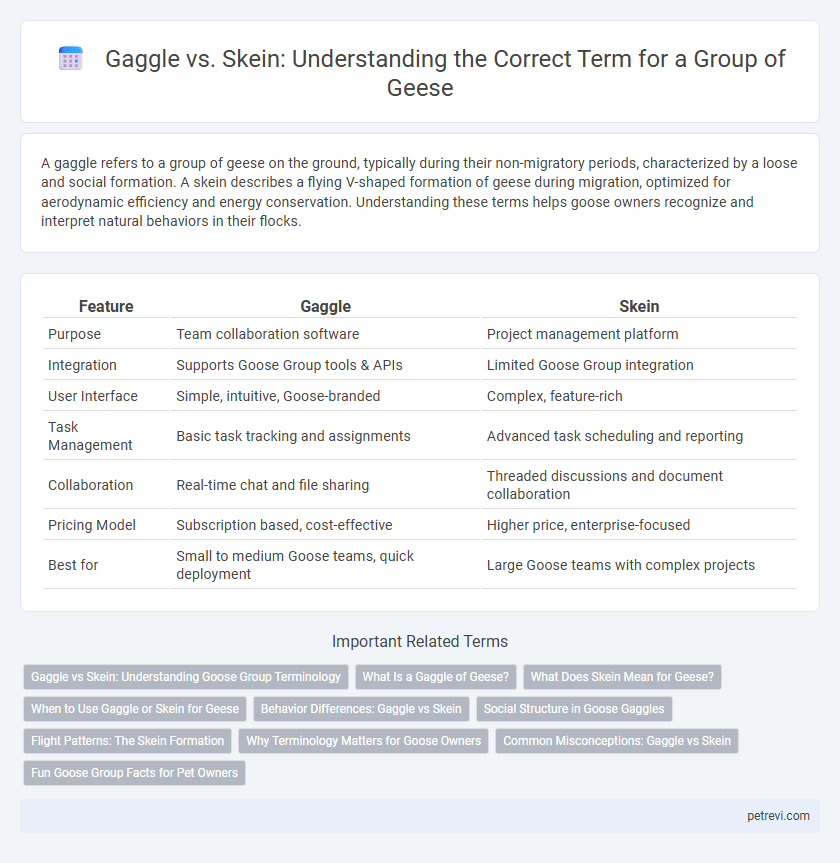A gaggle refers to a group of geese on the ground, typically during their non-migratory periods, characterized by a loose and social formation. A skein describes a flying V-shaped formation of geese during migration, optimized for aerodynamic efficiency and energy conservation. Understanding these terms helps goose owners recognize and interpret natural behaviors in their flocks.
Table of Comparison
| Feature | Gaggle | Skein |
|---|---|---|
| Purpose | Team collaboration software | Project management platform |
| Integration | Supports Goose Group tools & APIs | Limited Goose Group integration |
| User Interface | Simple, intuitive, Goose-branded | Complex, feature-rich |
| Task Management | Basic task tracking and assignments | Advanced task scheduling and reporting |
| Collaboration | Real-time chat and file sharing | Threaded discussions and document collaboration |
| Pricing Model | Subscription based, cost-effective | Higher price, enterprise-focused |
| Best for | Small to medium Goose teams, quick deployment | Large Goose teams with complex projects |
Gaggle vs Skein: Understanding Goose Group Terminology
A gaggle refers to a group of geese when they are on the ground or in the water, typically characterized by a loose, informal gathering. A skein describes a group of geese in flight, often flying in a V-formation which aids in aerodynamics and energy conservation. Understanding these terms is essential for distinguishing the behavior and location of geese within their natural group dynamics.
What Is a Gaggle of Geese?
A gaggle of geese refers to a group of geese when they are on the ground or in the water, characterized by their loose, unorganized formation. This term contrasts with a skein, which describes a group of geese in flight, often flying in a V-formation. Understanding these distinctions is essential for accurately describing the behavior and grouping of geese in different environments.
What Does Skein Mean for Geese?
A skein refers to a group of geese flying in a V-shaped formation, which optimizes aerodynamic efficiency and conserves energy during long migrations. This formation allows each bird to benefit from the air currents created by the bird in front, reducing wind resistance. Understanding skein behavior is essential for studying migratory patterns and social dynamics within goose populations.
When to Use Gaggle or Skein for Geese
A gaggle refers to a group of geese when they are on land or water, used to describe a loose, unstructured gathering primarily during resting or feeding periods. A skein, on the other hand, describes geese in flight, specifically when they are migrating or flying in a V-formation for aerodynamic efficiency and navigation. Use gaggle for stationary geese and skein to emphasize movement and flight dynamics in group behavior.
Behavior Differences: Gaggle vs Skein
A gaggle refers to a group of geese typically resting or feeding on land, characterized by loosely organized and relatively calm behavior, while a skein describes a flying formation of geese in a V-shape, demonstrating coordinated and aerodynamic movement patterns. Geese in a skein exhibit synchronized wingbeats and vocal communication to maintain formation and conserve energy during migration, whereas a gaggle shows more scattered interactions focused on social bonding and feeding. The behavioral differences between gaggle and skein reflect adaptations to either resting or migratory states within the goose species.
Social Structure in Goose Gaggles
A gaggle represents a social structure where geese form loose, ground-based groups typically during non-migratory periods, fostering communication and safety through vocalizations. In contrast, a skein describes a V-shaped flying formation used during migration to conserve energy and enhance aerodynamic efficiency. Understanding the distinctions between a gaggle and a skein highlights the adaptive social behaviors in goose groups, balancing foraging ground interactions with organized migratory coordination.
Flight Patterns: The Skein Formation
The skein formation features geese flying in a V-shaped pattern that reduces wind resistance and conserves energy for long-distance migration. Unlike a gaggle, which is a disorganized group of geese on the ground or water, the skein demonstrates precise aerodynamic efficiency during flight. This formation allows each goose to take advantage of the upwash created by the bird in front, optimizing stamina and maintaining cohesive navigation.
Why Terminology Matters for Goose Owners
Goose owners should understand the distinction between a gaggle and a skein to accurately describe their birds based on context; a gaggle refers to a group of geese on the ground, while a skein denotes geese in flight. Precise terminology enhances communication about goose behavior, care, and observation, crucial for enthusiasts and professionals alike. Mislabeling can lead to misunderstandings in both casual and scientific discussions about goose group dynamics.
Common Misconceptions: Gaggle vs Skein
A gaggle refers specifically to a group of geese resting on land or water, while a skein describes geese flying in a V-formation during migration. A common misconception is using these terms interchangeably, but each denotes a distinct state of geese behavior and location. Understanding the difference between a gaggle and a skein helps accurately describe goose group dynamics in ecological studies.
Fun Goose Group Facts for Pet Owners
A gaggle refers to a group of geese resting on land or water, while a skein describes geese flying in a V-formation during migration. Pet owners will find it fun that geese communicate using honks to coordinate group activities and maintain strong family bonds within their gaggle or skein. Understanding these group terms helps enthusiasts recognize natural behaviors and appreciate the social dynamics of domestic and wild geese.
Gaggle vs Skein for Goose Group Infographic

 petrevi.com
petrevi.com